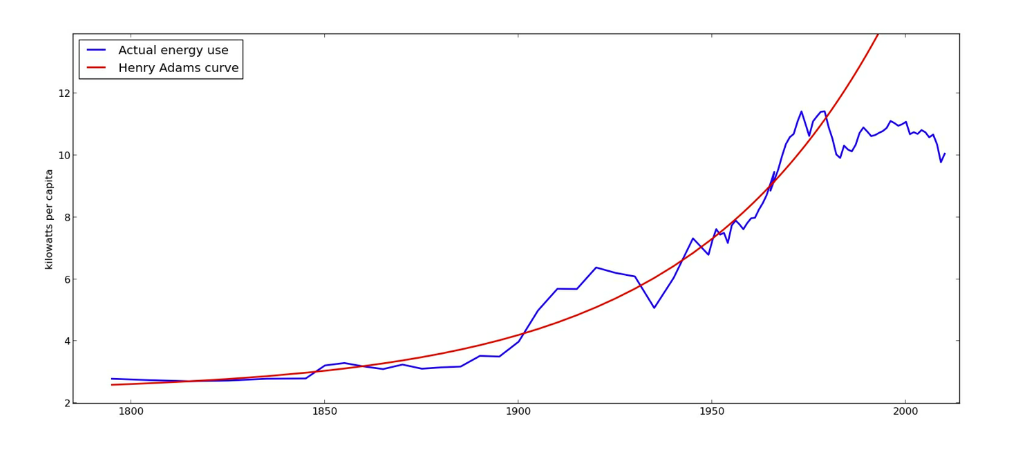To realise a sustainable future, do we need big technology and big investment in new directions – or is what we now have enough?
We have the technology we need – Sidmouth Solarpunk
Here’s a provocative look at how we can have both large and small scale:
Why we need the Jetsons and solarpunk
“We wanted flying cars, instead we got 140 characters.” Peter Thiel’s famous lament captures the disappointment of those of us raised on mid-20th-century technological optimism. Back in the 1960s we were sending men to the moon and exploring the ocean depths, and we thought we were just getting started. Back then, a bright and gleaming future beckoned with moon bases, space stations, underwater cities, limitless energy from fusion power, robots at our beck and call, and yes, flying cars. The pithiest way to sum up that future that never came: we were expecting “The Jetsons.” …
Peter Thiel made the crack that opens this essay during a 2013 talk at Yale; five years later, J. Storrs Hall self-published the quirky, brilliant Where Is My Flying Car? (subsequently reprinted by Stripe Press). Hall’s chart of the end of the “Henry Adams curve” – the chart shows energy consumption per capita growing exponentially until plateauing in the 1970s and stagnating ever since – captures in one arresting visual the road not taken. The change in perspective has provoked the formulation of a new reform agenda: revitalizing technological progress and economic dynamism after a half-century lull. Prominent voices in this space include Tyler Cowen and Patrick Collison and their call for a new “progress studies,” AEI scholar Jim Pethokoukis and his embrace of “upwing” dynamism and “conservative futurism,” Eli Dourado at the Center for Growth and Opportunity at Utah State, and the newish D.C. think tank the Institute for Progress.

This new current of opinion started out on the right, but has more recently lapped over onto the center-left. In the face of climate change and the need for a rapid transition to clean energy, some progressives have awakened to the huge obstacles posed by earlier progressive policies and entrenched progressive attitudes – namely, the permitting maze that makes building anything on a large scale prohibitively expensive, and the anti-Promethean habits of mind that gradually become indistinguishable from moss-backed conservatism. Here I’m referring to Ezra Klein and his “supply-side progressivism,” Derek Thompson and his “abundance agenda” – by the way, those two have now joined forces to coauthor a new book – and Matt Yglesias and his regular calls for energy abundance.
Jetsons-style technocratic futurism is thus making a comeback. The old obliviousness to environmental harms has been shed, along with visions of progress that left no room for the natural or the historical. Any futurism oriented toward genuine progress must now incorporate a commitment to minimizing environmental harms – but here an “ecomodernist” outlook replaces the anti-Promethean romanticism of old-style environmentalism.
Meanwhile, another species of optimistic futurism has been developing around the same time, this one with roots on the green, anti-technocratic, “small is beautiful” left. Here I’m talking about “solarpunk,” a sci fi genre/aesthetic/social movement. It’s best known through artwork – notably, images of futuristic cities swathed in greenery so that nature and artifice fuse seamlessly...
So let’s look at the core of the solarpunk vision, stripped of the ideological baggage that some people attracted to that vision have brought with them. At the heart of solarpunk is the idea of an environmentally sustainable high-tech future – and that’s the right idea! And it’s the right idea not just because we don’t want to wreck the planet, but because we don’t want to wreck technological dynamism, either. The only way to put the anti-Promethean backlash behind us is to develop technologies that allow humanity and the natural world to prosper together, thereby undermining the indiscriminate cultural hostility to technological progress that currently bogs us down. This is the future that solarpunk envisions. To get to that future, we need as many people as possible to find it attractive enough to work toward, and to fill out those numbers we need people from all ideological starting points.
Beyond this core commitment to clean energy abundance, solarpunk also clearly embraces a countercultural sensibility – an opposition to business-as-usual consumerism. And this is the right idea, too! But both solarpunk proponents who embrace it as a new species of anti-capitalism, and supporters of technocratic capitalist innovation who reject solarpunk for the same reason, are misunderstanding what is the optimal relationship between solarpunk and capitalism: not either-or, but both-and...
What matters is the substantive vision of the future, and the confident sense that it’s not just practically but morally superior to the status quo. That substantive vision – of technological progress that harmonizes human wellbeing with the wellbeing of the rest of the living world, and that allows a high degree of self-sufficiency at the local level – is one that supplies a crucial part of the answer to the permanent problem. (For those interested, the author of the passage I quoted above, Eric Hunting, has written a fascinating deep dive on how solarpunk society might evolve over time that I recommend checking out.)
It’s not the complete answer, though. We still need large-scale capitalism pursuing Jetsons-style progress: breakthroughs in geothermal, small modular nuclear, and fusion; translating those breakthroughs into conversion to indoor farming and cultivated meat; heading out into space to establish a permanent human presence and outsource mining to the asteroid belt; and pushing ahead with the AI revolution that will help make all of these other wonders possible.
The Jetsons future and the solarpunk future aren’t antagonists. There’s room for both, and there’s a need for both. The challenge ahead is managing their co-development and coexistence.
Why we need the Jetsons and solarpunk – Niskanen Center
…
